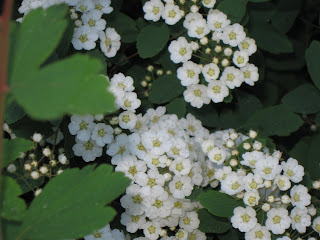


Potting Shed Poetry





 In the moon garden all four "corner" shrubs are in full bloom. The Snowball Viburnum and Bridal Wreath spirea at one end; the white beach rose and another Viburnum with horizontal blooms anchoring the other by the arbor. I am debating pruning the horizontal viburnum back this year vs. moving it. Anyway, these are common shrubs for a garden. They are striking and grouped together to anchor the Moon Garden their profuse white spring blooms are frame the space quite nicely.
In the moon garden all four "corner" shrubs are in full bloom. The Snowball Viburnum and Bridal Wreath spirea at one end; the white beach rose and another Viburnum with horizontal blooms anchoring the other by the arbor. I am debating pruning the horizontal viburnum back this year vs. moving it. Anyway, these are common shrubs for a garden. They are striking and grouped together to anchor the Moon Garden their profuse white spring blooms are frame the space quite nicely. 


 It's Friday, the first day of May and it's raining.
It's Friday, the first day of May and it's raining. A line from one of my in progress poems currently reads...
["drinking
tulips clink blush red cups
fall over in the rain"] (Eli)

In the front garden I tend to stick to the lavendars, pinks, whites etc. offsetting the yellow and cream daffodils.
They are in the second layer of the border and intermixed between the summer bulbs and irises to protect them from curious doe. It was a risk but it seems to have paid off. The risk being that the deer might "step" into the garden to find them and harm other plants.
Anyway, I lost some tulips on the border but not many. Much better than last year.
And in this last garden under the pink dogwood, a garden which I have been slowly deconstructing, the tulips have arisen with a new fierceness. They will not be defeated.
It's inevitable I suppose that where I want to plant them the deer notice them. And where I want to move them from, the deer leave them unnoticed.






For the hardy amongst us, providing a safe environment for spiders and snakes (snake skin) will also enhance nesting opportunities for these birds.
If you have Barn and Cliff swallows, phoebes, and robins in your area and want to encourage their nesting, consider creating or keeping a muddy puddle somewhere. I shallow metal pie tin you no longer use or that you pick up at a tag sale with some dirt you keep muddied will due.
I don’t recommend offering dryer lint.It doesn't withstand the rain and it may have chemical residues from the detergent which is harmful to birds.
Place the nest material around your garden
You can buy some fancy cages to hang these materials in around your yard. But you don't have to. For the fluffyier materials and the homemade combinations, you can gather them into an extra suet cage or even a set of extra wreath forms you bind together they can pick at.
Of course you can simply create "piles" of debris which works for a collection which isn't prone to blowing away. You might even push the material into the nooks and crannies of some mid-sized trees if you have them or drape them into your shrubs and small evergreens. Whatever method you consider, ask yourself "Could this potentially "harm" a bird or fledgeling" and if not, let your creativity unfold.
Be patient! Sometimes, it takes a while for the birds to find it. But they will. Whether or not they use it depends on how safe the area seems. If after a month or two it looks untouched, reexamine it's location from a bird's point of view. Does it offer to much exposure to predators?
Writer's Compost : So now you've collected your nest materials and offered them, maybe the birds have started to pick at it. Maybe you are still waiting for them to find the collection? Is this an opportunity for a list poem or a piece about: patience, offerings, anticipation, scraps?
Enjoy!
